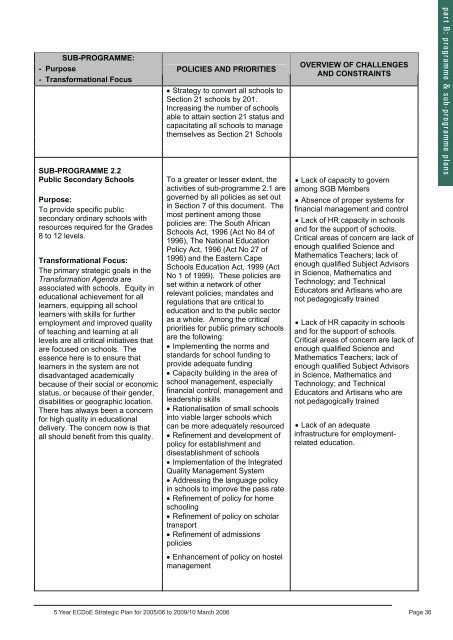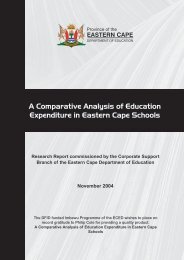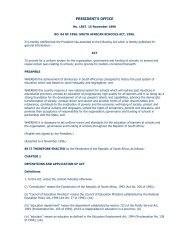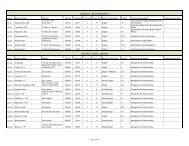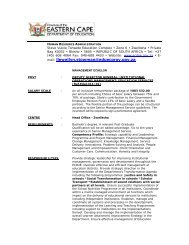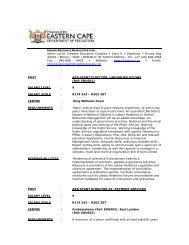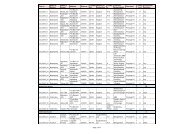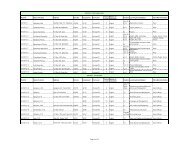5 Year Strategic Plan 2005/06 - Department of Education
5 Year Strategic Plan 2005/06 - Department of Education
5 Year Strategic Plan 2005/06 - Department of Education
You also want an ePaper? Increase the reach of your titles
YUMPU automatically turns print PDFs into web optimized ePapers that Google loves.
SUB-PROGRAMME:<br />
- Purpose<br />
- Transformational Focus<br />
SUB-PROGRAMME 2.2<br />
Public Secondary Schools<br />
Purpose:<br />
To provide specific public<br />
secondary ordinary schools with<br />
resources required for the Grades<br />
8 to 12 levels.<br />
Transformational Focus:<br />
The primary strategic goals in the<br />
Transformation Agenda are<br />
associated with schools. Equity in<br />
educational achievement for all<br />
learners, equipping all school<br />
learners with skills for further<br />
employment and improved quality<br />
<strong>of</strong> teaching and learning at all<br />
levels are all critical initiatives that<br />
are focused on schools. The<br />
essence here is to ensure that<br />
learners in the system are not<br />
disadvantaged academically<br />
because <strong>of</strong> their social or economic<br />
status, or because <strong>of</strong> their gender,<br />
disabilities or geographic location.<br />
There has always been a concern<br />
for high quality in educational<br />
delivery. The concern now is that<br />
all should benefit from this quality.<br />
POLICIES AND PRIORITIES<br />
Strategy to convert all schools to<br />
Section 21 schools by 201.<br />
Increasing the number <strong>of</strong> schools<br />
able to attain section 21 status and<br />
capacitating all schools to manage<br />
themselves as Section 21 Schools<br />
To a greater or lesser extent, the<br />
activities <strong>of</strong> sub-programme 2.1 are<br />
governed by all policies as set out<br />
in Section 7 <strong>of</strong> this document. The<br />
most pertinent among those<br />
policies are: The South African<br />
Schools Act, 1996 (Act No 84 <strong>of</strong><br />
1996), The National <strong>Education</strong><br />
Policy Act, 1996 (Act No 27 <strong>of</strong><br />
1996) and the Eastern Cape<br />
Schools <strong>Education</strong> Act, 1999 (Act<br />
No 1 <strong>of</strong> 1999). These policies are<br />
set within a network <strong>of</strong> other<br />
relevant policies, mandates and<br />
regulations that are critical to<br />
education and to the public sector<br />
as a whole. Among the critical<br />
priorities for public primary schools<br />
are the following:<br />
Implementing the norms and<br />
standards for school funding to<br />
provide adequate funding<br />
Capacity building in the area <strong>of</strong><br />
school management, especially<br />
financial control, management and<br />
leadership skills<br />
Rationalisation <strong>of</strong> small schools<br />
into viable larger schools which<br />
can be more adequately resourced<br />
Refinement and development <strong>of</strong><br />
policy for establishment and<br />
disestablishment <strong>of</strong> schools<br />
Implementation <strong>of</strong> the Integrated<br />
Quality Management System<br />
Addressing the language policy<br />
in schools to improve the pass rate<br />
Refinement <strong>of</strong> policy for home<br />
schooling<br />
Refinement <strong>of</strong> policy on scholar<br />
transport<br />
Refinement <strong>of</strong> admissions<br />
policies<br />
Enhancement <strong>of</strong> policy on hostel<br />
management<br />
OVERVIEW OF CHALLENGES<br />
AND CONSTRAINTS<br />
<br />
<br />
Lack <strong>of</strong> capacity to govern<br />
among SGB Members<br />
Absence <strong>of</strong> proper systems for<br />
financial management and control<br />
Lack <strong>of</strong> HR capacity in schools<br />
and for the support <strong>of</strong> schools.<br />
Critical areas <strong>of</strong> concern are lack <strong>of</strong><br />
enough qualified Science and<br />
Mathematics Teachers; lack <strong>of</strong><br />
enough qualified Subject Advisors<br />
in Science, Mathematics and<br />
Technology; and Technical<br />
Educators and Artisans who are<br />
not pedagogically trained<br />
Lack <strong>of</strong> HR capacity in schools<br />
and for the support <strong>of</strong> schools.<br />
Critical areas <strong>of</strong> concern are lack <strong>of</strong><br />
enough qualified Science and<br />
Mathematics Teachers; lack <strong>of</strong><br />
enough qualified Subject Advisors<br />
in Science, Mathematics and<br />
Technology; and Technical<br />
Educators and Artisans who are<br />
not pedagogically trained<br />
Lack <strong>of</strong> an adequate<br />
infrastructure for employmentrelated<br />
education.<br />
<br />
<br />
<br />
<br />
<br />
<br />
<br />
<br />
<br />
p a r t B : p r o g r a m m e & s u b - p r o g r a m m e p l a n s<br />
5 <strong>Year</strong> 5 ECDoE <strong>Year</strong> ECDoE <strong>Strategic</strong> <strong>Strategic</strong> <strong>Plan</strong> for <strong>Plan</strong> <strong>2005</strong>-<strong>06</strong> for <strong>2005</strong>/<strong>06</strong> to 2009-10. to 2009/10 21 F (1).doc March 20<strong>06</strong> Page 34 Page 36


